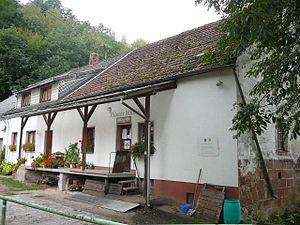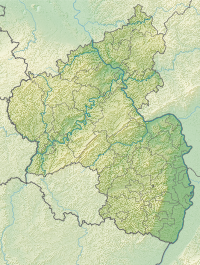Hilster mill
| Hilster mill
|
||
|---|---|---|
|
Hilster mill in the Trualbtal |
||
| Location and history | ||
|
|
||
| Coordinates | 49 ° 8 '7 " N , 7 ° 30' 53" E | |
| Location | Trualbtal, between the communities Schweix and Kröppen | |
| Waters | Trualbe | |
| Built | unknown; 1583 oldest documented mention | |
| Shut down | December 31, 2009 | |
| Status | well preserved; inhabited | |
| technology | ||
| use | Flour mill | |
| drive | Francis shaft turbine | |
The Hilster Mühle is a watermill , which is located in the association of Pirmasens-Land in the district of Südwestpfalz ( Rhineland-Palatinate ) and in which grain has been ground for centuries ( grain mill ).
location
The mill is located in the district of Schweix in the narrow Trualbe valley between Schweix and Kröppen . The catchment area of the mill is located in the area of the Westrich plateau , which merges a few kilometers east into the low mountain range of the German and French Wasgau . While the heights in the immediate vicinity of the mill are used for agriculture and were therefore important as a supplier of grist, the landscape is dominated by extensive forests in the direction of Eppenbrunn and Roppweiler in Lorraine (French: Roppeviller).
The Trualbe rises on the northeastern outskirts of Trulben and leaves German territory about 2 kilometers west of the Hilster Mühle in order to reach the French municipality of Walschbronn ( Lorraine ) in the Northern Vosges Nature Park shortly afterwards . After a further 2 kilometers the Trualbe joins the Hornbach near Waldhausen (French: Waldhouse ) .
Surname
The name comes from the former stately Hilster Weiher in the Trualbtal. This pond was created by the Counts of Lemberg and no longer exists today. In addition to the stately fish farming, the pond served as a water reservoir, which powered the mill in dry times.
history
Important events (1583-1917)
The actual year the mill was founded is not known. It was first mentioned in a document in a bequest from 1583 to the lordly fief miller Sebastian Heins.
During the Thirty Years' War the mill was destroyed and therefore abandoned, after the war it was rebuilt. Only 19 years later the building was destroyed again by a fire in 1667, so that further reconstruction, which took place in 1680, was necessary. Among other things, oak beams were used here, which have been preserved to this day. Further changes to the mill site took place in 1710 with the construction of the 1700 meter long mill ditch , which is also still preserved.
As a result, the mill often changed hands; Mention should be made, for example, of the miller Peter Esch from the Walshausermühle , who took over the business in 1866.
The turmoil of the First World War increasingly impaired the mill operations, which finally led to the forced closure of the mill in 1917 because of "grinding without grinding tickets".
Modernization of the mill (1919–1935)
After the end of the First World War, Johann Würtz from Eppenbrunn bought the mill in 1919. It soon turned out to be necessary to modernize the mill's drive technology. In 1929, the medium-sized water wheel was replaced by a Francis shaft turbine , which was in operation until the mill was shut down in 2009. These technical innovations resulted in fundamental renovation measures for the entire mill building, which could be carried out in 1935.
Conflicts during National Socialism (1939–1944)
In the course of the expansion of the Bitsch military training area , on September 1, 1939, 18 municipalities from the Bitsch region and the three Palatinate villages of Hilst, Riedelberg and Schweix were completely evacuated so that agriculture could no longer be carried out there. As a result, there were no orders in the Hilster mill, so that the grinding operation came to a standstill. Thereupon the Wehrmacht dismantled the machinery except for the turbine in 1942 and sold it at the scrap price in Franconia . Like the communities of Schweix, Hilst and Riedelberg, the mill was to become part of the Bitsch military training area. Johann Würtz lodged a protest at the food office in Kaiserslautern against a declaration of renunciation, whereupon the matter was postponed until "after the final victory". As a result of this protest, the responsible authorities ordered the Hilster mill to be excluded from the military training area in 1943; this made it possible for the Würtz family to return to their home. In addition to the grinding operation, the miller took over the duty of the gatekeeper at the shooting range . However, there was another evacuation in 1944 because of the advancing American forces.
Reconstruction and renewed milling operations (1945–1960)
After 1945 a new reconstruction took place, which was associated with considerable difficulties in the first post-war years. For example, trips through the whole of the Palatinate and Saarland were required to procure the necessary milling machines. How important it was at this time to have suitable technology available on site is shown by the fact that the water turbine was temporarily used as the only driving force in the surrounding villages. In the years 1949 and 1950, this preliminary technical work was finally completed, so that grinding operations were resumed. The performance of the mill had improved so that as early as 1950 200 tons of grain could be ground.
Economic Problems and Closure (1960-2009)
In 1960 the Salamander shoe group set up a branch in Trulben. As a result, many small farmers from Trulben and the surrounding area gave up their operations and took over a job in this factory. As a result, the mill lost a large number of suppliers, so that the corresponding milling orders were lost. In order to compensate for this, feed was also sold from this point on and wholemeal wheat and rye flours were produced since 1983 .
Because of a landslide, it turned out to be necessary to close the mill access from February 3, 1994 for almost three years. This resulted in considerable driving and transport problems for customers and for the mill itself, especially in the winter months, so that the entire grinding operation was severely impaired. After Albert Würtz's death in 2005, the mill was initially run by his son Hans Würtz as a part-time business until the mill finally ceased grinding on December 31, 2009. It was thus the last functioning small border mill, so that when it was closed, a centuries-old mill culture typical of the region came to an end.
Future use
Various municipalities in the Southwest Palatinate region have come together to help shape the future development of this region within the framework of "Integrated Rural Development" (ILE). The work is based, among other things, on various key projects, one of which, due to the large number of mills in the region, deals with “mill culture and the fascination of water”. In this context, the ILE project group “Kulturgut Bauernhof” came up with the idea of transforming the Hilster mill into a museum mill. To this end, the historic mill is to be renovated first and then made accessible to a wider public - for example through group tours. In a call on May 6, 2011, the project group drew attention to these plans and asked interested citizens to participate.
literature
- Hans Würtz: Borderland fate of a West Palatinate mill: the Hilstermühle in Schweix (district of Südwestpfalz) . In: lucky too! , German Society for Milling Knowledge and Mill Conservation, Landesverband Rheinland-Pfalz and Saarland eV, Altenkirchen 2008, pp. 124–126,
Web links
- German Society for Milling Science and Mill Maintenance (DGM) e. V.
- Integrated rural development concept (ILEK) for the South West Palatinate region
Individual evidence
- ↑ Local community Schweix ( Memento from December 28, 2014 in the Internet Archive ) on the website of the Verbandsgemeinde Pirmasens-Land
- ^ Institut Geographique National (Ed.): Carte Topographique 1: 25,000, Pays de Bitche . Institut Geographique National, Paris 1998
- ^ A b Verbandsgemeinden Südwestpfalz (Hrsg.): Integrated rural development concept (ILEK) for the region Südwestpfalz . Final report. ( edoweb-rlp.de ).
- ^ Verbandsgemeinde Pirmasens-Land (Ed.): Call of the ILE project group "Kulturgut Bauernhof" for the IG "Use of the Hilster mill as a museum mill" . In: Official Journal of the Verbandsgemeinde Pirmasens-Land from May 6, 2011. Pirmasens 2011


